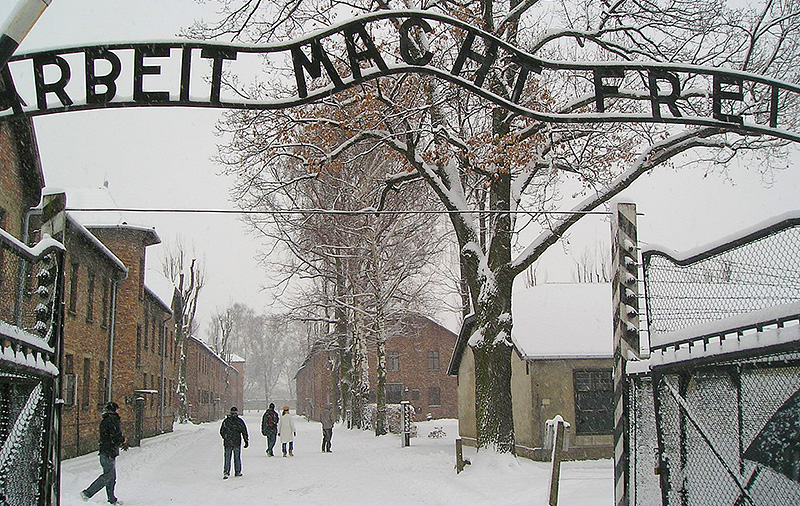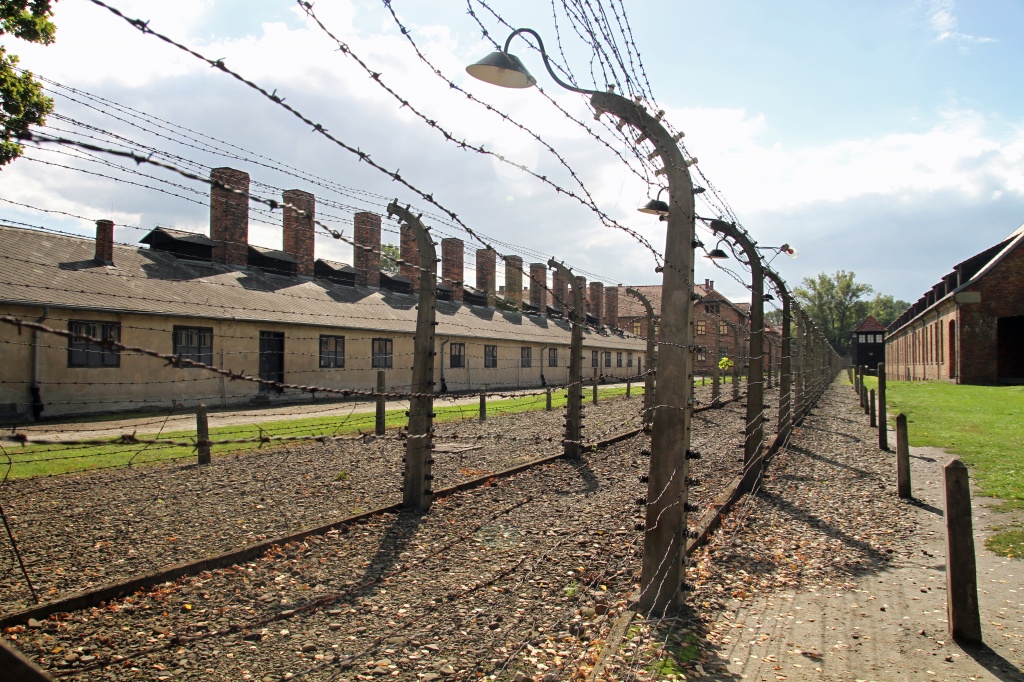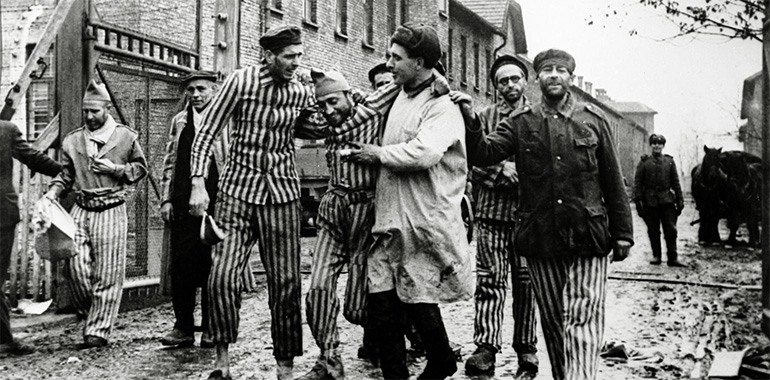
“People were poisoned with bedbug insecticides”. How the deadliest Auschwitz concentration camp functioned
/ Главная / Russkiy Mir Foundation / Publications / “People were poisoned with bedbug insecticides”. How the deadliest Auschwitz concentration camp functioned“People were poisoned with bedbug insecticides”. How the deadliest Auschwitz concentration camp functioned
Alexander Dobrovolsky
75 years ago, the Red Army liberated the Oświęcim concentration camp (the Auschwitz) - perhaps the deadliest Nazi concentration camp, which became a symbol of the Holocaust and quintessential example of inhumanity of the Hitler regime. However, in the war and post-war history of the world-known concentration camp, there were episodes that are still in the shadow of “zeitgeist biography” of the “death factory” replicated by mass media…
The concentration camp dates back its history back to 1940. In the spring, barracks of the former military camp of the Polish army located near the town of Oświęcim (Germans called it Auschwitz) were converted into a concentration camp at the order of Himmler. Its first prisoners were 30 German criminals brought there in early June. They were transferred from a prison in Sachsenhausen. And on June 14, a freight train brought to Auschwitz the first large batch of "doomed to death" - 728 Polish political prisoners.

Gates of the Auschwitz concentration camp
In July of that year, a “Soviet” group of captured Red Army soldiers was brought to the Oświęcim camp. All of them were doomed to extermination: after all, that batch of people consisted of commanders and political workers.
* * *
By August 1944, the Oświęcim became the largest concentration camp established by the Reichsführer Himmler office. There were up to 130 thousand prisoners behind the barbed wire at the same time.
Every day, up to 10 trains of 40 to 50 wagons packed with fifty to one hundred people each arrived at a discharge site in front of the camp area by a specially constructed access railway line. A significant part of new-comers were sent to the gas chambers within the first few hours
* * *
People in the Oświęcim were mostly exterminated by poisoning with the Zyklone B gas. This horrible chemical agent was initially made for bed bugs and other domestic insect pest control. The insecticide was developed by a group of German scientists led by Fritz Haber, a Nobel Prize winner, in 1922. Later, after the outbreak of the World War II, the "inventors" from Himmler’s office decided to use it for mass poisoning of "unwanted" and "harmful" people.
It was the Oświęcim camp where Zyklone B had such inhuman debut.
Rudolf Höss, the first camp commandant, said in his testimony of at the Nuremberg trials:
“...In June 1941, I received orders to install Jewish extermination equipment in Auschwitz. When I equipped the extermination building in Auschwitz, I adapted it to use the Zyklone B gas... Another improvement made by us was the construction of gas chambers with a one-time pass through capacity of two thousand people...”
The first "mass extermination action" was carried out on September 3, 1941. About 600 captured Red Army soldiers and 250 Poles were killed by the Zyklone in the "experimental" gas chamber equipped in the basement of block No.11. That chamber was used until 1942, when new, more efficient gas chambers were put in operation in Oświęcim. And the Germans converted their first project into a safety facility - a bomb shelter.
Being obsessed with order and proper work organization management – any work! - the Nazis tried to make killing prisoners of the concentration camp fit in with disposing of their remains. Heavy duty crematoriums were built in addition to heavy duty gas chambers in the Oświęcim. However, sometimes the “Zyklone B experts” were so much energized by orders of their supervisors that the crematorium furnaces could not keep up with them. In such cases, some bodies of the dead were burned in ditches dug on the fringe of the Auschwitz-2 camp.

Camp fencing. Photo credit: pxhere.com
* * *
The Nazis provided harsh living conditions, as well as a whole system of punishments for violating the strict camp order for those “lucky ones” who escaped being sent to the gas chambers on the very first day after arriving at the “death factory”. For example, the Germans arranged so-called “standers” - standing wards in block No.11 of the Auschwitz-1 camp. Four people were placed into such a tiny room with an area of 90x90 cm and left for the whole night. Those poor souls couldn’t even squat down on haunches, and within a few hours they began to suffer severe cramps in their legs.
But it was still a “humane” punishment. For more serious faults, prisoners were put in a special airproof sealed cell. Once there, they suffered from increasing oxygen deficiency. If the torture lasted way too long, people simply died of asphyxia.
* * *
Part of the Auschwitz-1, the very first Oświęcim camp territory, was later converted by the Germans into a “service area” for the camp guard. For example, a fairly presentable bordel was arranged on the second floor of the former detention block No. 24 in the middle of the Second World War. Supervisors selected the prettiest young women from among the groups arriving at the Oświęcim to work in it.
* * *
Some of prisoners who arrived at the concentration camp — the strongest young men and women — were selected to work at industrial enterprises located in the region (the owners of factories and plants paid rather decent money to the camp administration for such free labor allowance). According to the information collected by historians and researchers, about 400 thousand people became “Arbeiters” during five years of the concentration camp existence in Oświęcim. More than 340 thousand of those unfortunate people died being unable to withstand harsh working conditions, as well as illnesses, frequent beatings and even executions carried out by guards.
* * *
Several prisoners who worked in the Sonderkommando burying ashes of burnt corpses in specially dug large pits wrote “messages to the future”. Those letters of testimony were addressed to their relatives and told about the horrors that were happening in the Auschwitz. Nine such notes were discovered during excavations at the site of the former concentration camp in the post-war years; their texts were published.

Prisoners of the concentration camp. Photo credit: jewishnews.com.ua
* * *
One of the prisoners who died in the Oświęcim camp was subsequently canonized by the Catholic Church. We are talking about a Polish military priest who was captured by the Germans together with others and volunteered to go to the death camp instead of one of his comrades. The padre’s name was Maximilian Maria Kolbe.
* * *
Ukrainian nationalist figures Alexander and Vasily Bandera, two younger brothers of the notorious Stepan Bandera, were among the Oświęcim victims. (The first of them was given a lethal injection at the order of the camp doctor, and the second one was pushed down during construction work at height).
Aron Simanovich, a very odious character of the Russian pre-revolutionary history and the personal secretary of the spiritual advisor Grigory Rasputin, ended his days at this "factory of death".
* * *
Over the period of existence of the horrible concentration camp, its prisoners repeatedly made attempts to escape – in groups and individually. After analyzing the archival documents, the researchers discovered that nearly 900 prisoners in total had made attempts to escape from the Oświęcim camp. Less than 150 ofthen survived and were saved.
According to the surviving information, the first successful escape was performed shortly after the camp establishment - in July 1940. The man who managed to break free from Oświęcim turned out to be Tadeusz Vievsky, a Polish shoemaker. His escape became possible due to the fact that the concentration camp was being actively built then, its borders were not yet fully equipped to provide reliable protection, and brigades of civilian laborers worked within the territory. And those laborers helped Tadeusz slip out of the perimeter of barbed wire unnoticed, secretly giving him civilian clothes and hiding him within their crowd while leaving the gates after the end of the working day.
In June 1942, a group of four prisoners, led by Kazimierz Piechowski, a Polish man, was able to escape. They managed to steal an officer uniform, which Kazimierz put on. Yevgeny Bendera, his accomplice and a car mechanic, was able to use a prefabricated duplicate key to start a car, in which prisoners led by the “officer”, safely passed through the camp gates and dashed away; then they were doubling and hiding in the forests for a long time.
* * *
Among the millions of the Oświęcim prisoners, there was at least one of them who had entered the concentration camp voluntarily. From the first days of the World War II, Witold Pilecki fought with the Germans in the ranks of the Polish army, and after the Nazis occupied the country, he joined the Polish resistance. When, at the end of 1940, leaders of the underground received information about the horrors being performed by the Nazis at the Oświęcim camp, they took decision to send their intelligence officer to this “death factory” so that he would find out what was happening there in detail.
Pilecki volunteered to accomplish the most dangerous task. Using fake documents, he provoked his arrest and was sent to the concentration camp. The member of the underground was able to stay in Oświęcim and lucky enough to avoid the gas chamber for more than two years. The Nazis assigned him to labor brigades; and he managed to repeatedly send notes off with the information about the camp. In the spring of 1943, the brave Pole decided to escape from the dungeons so he could personally convince his resistance comrades of the need to attack the concentration camp and release its prisoners. Being on duty in a bakery located outside the guarded area, Pilecki and his two comrades seized the moment when the guard on watch was distracted and managed to escape. However, Vitold failed to implement his plan in full. He reached Warsaw and met with the leadership of the Polish resistance, but was not able to convince them to organize an attack on the Oświęcim camp.
* * *
Rudolf Höss, the very first commandant and "equipper" of the Oświęcim camp and SS functionary, tried to hide in the British occupation zone at the end of the war. But he was extradited by the British to the Polish side. The international tribunal sentenced Höss to death. In April 1947, the Nazi criminal was hanged not far from his "pet project" - the first crematorium in the Auschwitz-1 camp territory.

Soviet doctors treated liberated prisoners of the concentration camp
* * *
For several months after liberation of the Oświęcim camp by the Red Army, some of its buildings were arranged into the temporary hospital. Here doctors saved lives and treated survived prisoners of the "death factory”.
At the end of the war and until 1947, some of the Oświęcim camp permanent stone buildings were again turned into prison. A special-purpose prison was arranged here. People's Commissariat for Internal Affairs of the USSR and the newly formed Ministry of Public Security of Poland used it for their needs.
* * *
According to Franciszek Piper, a Polish scholar and one of the most respected researchers of the history of the Oświęcim camp, the numbers of people who died in the concentration camp for the entire time of its existence are the following:
Jews — about 1 million,
Poles — from 70 to 75 thousand,
Gypsies — 21 thousand,
Soviet prisoners of war - 15 thousand,
Others (Czechs, Yugoslavs, French, Austrians ...) - 15 thousand.
At the same time, Rudolf Höss, who had served as the commandant of the concentration camp in 1940–1943, testifying at the Nuremberg trials, gave a different estimate of the Oświęcim camp victims: up to 2.5 million people.
New publications

 Mikhail Kalatozov, a director who transformed the world of cinematography in many ways, was born 120 years ago. He was a Soviet film official and a propagandist. Above all, he was capable of producing movies that struck viewers with their power and poetic language.
Mikhail Kalatozov, a director who transformed the world of cinematography in many ways, was born 120 years ago. He was a Soviet film official and a propagandist. Above all, he was capable of producing movies that struck viewers with their power and poetic language.  Ukrainian authorities have launched a persecution campaign against the canonical Ukrainian Orthodox Church (UOC), the biggest one in the country's modern history. Over the past year, state sanctions were imposed on clergy representatives, searches were conducted in churches, clergymen were arrested, criminal cases were initiated, the activity of the UOC was banned in various regions of the country, and monasteries and churches were seized.
Ukrainian authorities have launched a persecution campaign against the canonical Ukrainian Orthodox Church (UOC), the biggest one in the country's modern history. Over the past year, state sanctions were imposed on clergy representatives, searches were conducted in churches, clergymen were arrested, criminal cases were initiated, the activity of the UOC was banned in various regions of the country, and monasteries and churches were seized.  When Nektary Kotlyaroff, a fourth-generation Russian Australian and founder of the Russian Orthodox Choir in Sydney, first visited Russia, the first person he spoke to was a cab driver at the airport. Having heard that Nektariy's ancestors left Russia more than 100 years ago, the driver was astonished, "How come you haven't forgotten the Russian language?" Nektary Kotlyaroff repeated his answer in an interview with the Russkiy Mir. His affinity to the Orthodox Church (many of his ancestors and relatives were priests) and the traditions of a large Russian family brought from Russia helped him to preserve the Russian language.
When Nektary Kotlyaroff, a fourth-generation Russian Australian and founder of the Russian Orthodox Choir in Sydney, first visited Russia, the first person he spoke to was a cab driver at the airport. Having heard that Nektariy's ancestors left Russia more than 100 years ago, the driver was astonished, "How come you haven't forgotten the Russian language?" Nektary Kotlyaroff repeated his answer in an interview with the Russkiy Mir. His affinity to the Orthodox Church (many of his ancestors and relatives were priests) and the traditions of a large Russian family brought from Russia helped him to preserve the Russian language.

 The leaders of the Friends of the Great Russia cultural association (Amici Della Grande Russia) in Italy believe that the Western policy of abolishing Russian culture in Europe has finally failed. Furthermore, it was doomed to failure from the beginning.
The leaders of the Friends of the Great Russia cultural association (Amici Della Grande Russia) in Italy believe that the Western policy of abolishing Russian culture in Europe has finally failed. Furthermore, it was doomed to failure from the beginning.  Name of Vladimir Nemirovich-Danchenko is inscribed in the history of Russian theater along with Konstantin Stanislavski, the other founding father of the Moscow Art Theater. Nevertheless, Mr. Nemirovich-Danchenko was a renowned writer, playwright, and theater teacher even before their famous meeting in the Slavic Bazaar restaurant. Furthermore, it was Mr. Nemirovich-Danchenko who came up with the idea of establishing a new "people's" theater believing that the theater could become a "department of public education."
Name of Vladimir Nemirovich-Danchenko is inscribed in the history of Russian theater along with Konstantin Stanislavski, the other founding father of the Moscow Art Theater. Nevertheless, Mr. Nemirovich-Danchenko was a renowned writer, playwright, and theater teacher even before their famous meeting in the Slavic Bazaar restaurant. Furthermore, it was Mr. Nemirovich-Danchenko who came up with the idea of establishing a new "people's" theater believing that the theater could become a "department of public education."  "Russia is a thing of which the intellect cannot conceive..." by Fyodor Tyutchev are famous among Russians at least. December marks the 220th anniversary of the poet's birth. Yet, he never considered poetry to be his life's mission and was preoccupied with matters of a global scale. Mr.Tyutchev fought his war focusing on relations between Russia and the West, the origins of mutual misunderstanding, and the origins of Russophobia. When you read his works today, it feels as though he saw things coming in a crystal ball...
"Russia is a thing of which the intellect cannot conceive..." by Fyodor Tyutchev are famous among Russians at least. December marks the 220th anniversary of the poet's birth. Yet, he never considered poetry to be his life's mission and was preoccupied with matters of a global scale. Mr.Tyutchev fought his war focusing on relations between Russia and the West, the origins of mutual misunderstanding, and the origins of Russophobia. When you read his works today, it feels as though he saw things coming in a crystal ball...